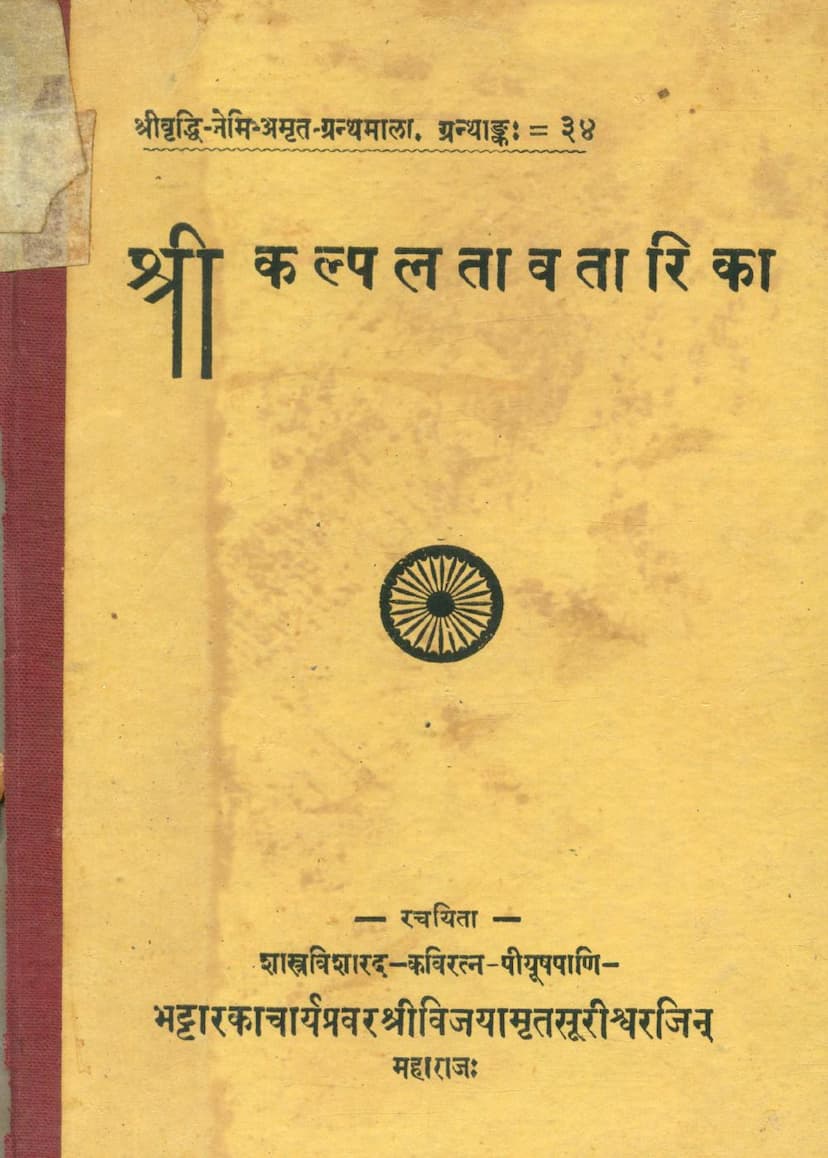Kalplatavatarika
Added to library: September 2, 2025

Summary
Here is a comprehensive summary of the Jain text "Kalplatavatarika" by Amrutsuri, based on the provided pages:
Title: Kalplatavatarika (कल्पलतावतारिका)
Author: Vijayamrutsurishwarjin Maharaj (श्री विजयामृतसूरीश्वरजिन महाराजा), also referred to as Amrutsuri (अमृतसूरि) or Vijayamrutsuri (विजयामृतसूरि) and described as a scholar (शास्त्रविशारद), poet (कविरत्न), and possessing skillful hands (पीयूषपाणि).
Publisher: Shri Jain Sahityavardhak Sabha, Shirpur (पश्चिम खानदेश).
Series: Shri Vruddhi Nemi Amruth Granthamala (श्री-वृद्धि-नेमि-अमृत-ग्रन्थमाला), Granthank (Volume Number) 34.
Work it is a Commentary On: The text is a commentary on the "Syadvada Kalpalata" (स्याद्वादकल्पलता), which itself is a commentary by Mahopadhyaya Yashovijayji Gani (महोपाध्याय श्री यशोविजयजिद्गणिन) on the "Shastra Varta Samuccaya" (शास्त्रवार्तासमुच्चय). The original author of "Shastra Varta Samuccaya" is Shri Haribhadra Suri (श्री हरिभद्रसूरिजी महाराज).
Purpose of the Kalplatavatarika: The introduction explains that the original work, "Shastra Varta Samuccaya," is a profound philosophical treatise that requires significant expertise to understand. Yashovijayji's commentary, "Syadvada Kalpalata," is vast and complex, making it challenging for many to access its deep philosophical insights. The "Kalplatavatarika" was written by Vijayamrutsurishwarji to provide an accessible entry point to Yashovijayji's commentary, making its study easier and more widespread. The author mentions that when he first read "Syadvada Kalpalata," he was particularly drawn to the relevant aphorisms (sūktas) and initially intended to extract and explain them. However, the final version of "Kalplatavatarika" also includes relevant verses from the original text and associated philosophical discussions to facilitate a deeper understanding.
Structure and Content Overview (based on the detailed stanzas):
The book is structured into eleven stanzas (stavas), each addressing different philosophical schools and concepts:
- Stavak 1: Begins with auspicious verses praising the Jinapati (Lord Mahavir) and discusses the importance of the author and commentator. It then starts the philosophical discourse by outlining the fundamental principles of Jain philosophy, including the nature of the soul (Atma), its purity marred by karma, and the concept of liberation. It also begins the critique of other philosophical systems, starting with the Charvaka (materialistic) viewpoint, refuting their denial of the soul and soul's existence through logic and evidence. The commentary also addresses the Naiyayikas (logicians) and their arguments.
- Stavak 2: Focuses on the controllers of the universe (Vishwataṇṭra), discussing five potential causes identified by various philosophers: Time (Kala), Nature/Inherent Disposition (Svabhava), Destiny (Niyati), Karma (Karma), and Effort/Personal Energy (Purushartha). The text analyzes each of these individually, presenting their arguments and then the Jain perspective that all five contribute in their own way to the functioning of the universe.
- Stavak 3: Critically examines the Samkhya philosophy, particularly its concept of God's role in creation. It discusses how some philosophers attribute creation to God, while others, like Samkhya, attribute it to Prakriti (primordial matter). The text elaborates on the Samkhya theory of 25 tattvas (principles), tracing the emanation from Prakriti to the final elements. It then reconciles Samkhya's view of Prakriti being the source of the material world with the Jain understanding of karma as the basis of worldly existence.
- Stavaks 4, 5, 6: These three stanzas are dedicated to the detailed analysis and refutation of various schools within Buddhism. The text discusses the Vaibhāṣikas (who accept external objects), Sautrāntikas (who deny direct perception of external objects), Yogācāras (who believe reality is mind-only), and the Mādhayamikas (who advocate emptiness). It delves into core Buddhist doctrines like momentariness (Kṣaṇikavāda) and consciousness-only (Vijñānavāda), systematically refuting their positions with logical arguments.
- Stavak 7: Presents the core tenets of Jain philosophy. This includes the dualistic nature of the universe (Jiva and Ajiva), the concept of reality as having existence, change, and permanence (Utpāda-vyaya-dhrauvya-yukta), the importance of Syadvada (the doctrine of conditional predication), and the application of the Seven-Fold Predication (Saptabhaṅgī) to understand reality comprehensively.
- Stavak 8: Discusses the Vedantic philosophy, particularly the concept of Brahman as the sole reality (Brahma sat, Jagat mithya – Brahman is real, the world is illusory). It critiques the concept of Maya (illusion) and the Vedantic view of reality being fundamentally non-dual. The text emphasizes the Jain perspective that all phenomena have distinct realities.
- Stavak 9: Focuses on the concept of liberation (Moksha). It examines different philosophical views on what Moksha is, where it is attained, and how it is achieved, pointing out inconsistencies and flaws in non-Jain perspectives. It reasserts the Jain path to liberation through Right Knowledge, Right Faith, and Right Conduct (Samyak-jñāna-darśana-cāritra). It also refutes the denial of liberation for women and those who wear clothes by Digambara Jains.
- Stavak 10: Analyzes the Mimāmsaka philosophy, addressing their rejection of omniscience (Sarvajña). The text first explains the Mimāmsaka arguments against omniscience and then proceeds to establish the existence of omniscience from a Jain perspective. It also discusses the authority of the Vedas and refutes the Mimāmsaka concept of violence prescribed in rituals.
- Stavak 11: Discusses the relationship between words (Shabda) and their meanings (Artha). It critiques Buddhist concepts like Apoha (exclusionary definition) and establishes the Jain understanding of the conventional and ultimate nature of language and meaning. It concludes by reaffirming the importance of the Syadvada (many-sidedness) approach to understanding reality.
Overall Significance:
The "Kalplatavatarika" serves as a crucial guide for accessing the profound philosophical arguments presented in the "Syadvada Kalpalata" and, by extension, the "Shastra Varta Samuccaya." It aims to simplify complex debates and present the Jain viewpoint in a clear and persuasive manner, demonstrating the author's deep scholarship and his commitment to making these vital teachings accessible to a wider audience. The author's intention is to lead readers towards the correct path (Sammarga) and the ultimate goal of liberation.